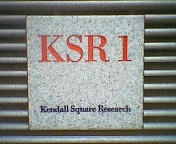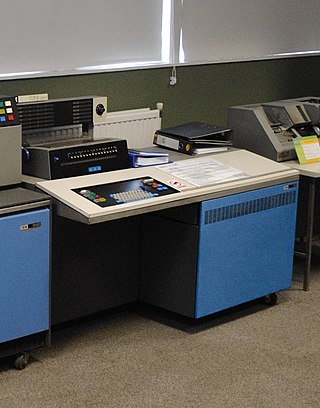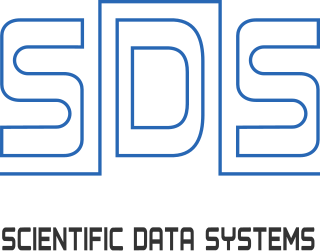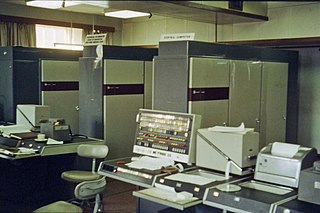
The SDS 930 was a commercial 24-bit computer using bipolar junction transistors sold by Scientific Data Systems. It was announced in December 1963, with first installations in June 1964. [1]

The SDS 930 was a commercial 24-bit computer using bipolar junction transistors sold by Scientific Data Systems. It was announced in December 1963, with first installations in June 1964. [1]
This section may require cleanup to meet Wikipedia's quality standards. The specific problem is: This section should be written in the past tense.(March 2024) |
An SDS 930 system consists of at least three standard (30 cu ft, 0.85 m3) cabinets, weighing about 3,200 pounds (1.6 short tons; 1.5 t). [2] It is composed of an arithmetic and logic unit, at least 8,192 words (24-bit + simple parity bit) magnetic-core memory, and the IO unit. Two's complement integer arithmetic is used. The machine has integer multiply and divide, but no floating-point hardware. [3] An optional correlation and filtering unit (CFE) can be added, which is capable of very fast floating-point multiply-add operations (primarily intended for digital signal processing applications).
A free-standing console is also provided, which includes binary displays of the machine's registers and switches to boot and debug programs. User input is by a Teletype Model 35 ASR unit and a high-speed paper-tape reader (300 cps). Most systems include at least two magnetic-tape drives, operating at up to 75 in/s at 800 bpi. The normal variety of peripherals is also available, including magnetic-drum units, card readers and punches, and an extensive set of analog-digital/digital-analog conversion devices. A (vector mode) graphic display unit is also available, but it does not include a means of keyboard input.[ citation needed ]
The SDS 930 is a typical small- to medium-scale scientific computer of the 1960s. Speed is good for its cost, but with an integer add time of 3.5 microseconds, it is not in the same league as the scientific workhorses of the day (the CDC 6600, for example). A well equipped 930 can easily exceed 10 cabinets and require a 300–500 sq ft (28–46 m2) climate-controlled room. The price of such a system in 1966 would be in the neighborhood of $500K.[ citation needed ]
Programming languages available include FORTRAN II, ALGOL 60, and the assembly language known as Meta-Symbol. The FORTRAN system is very compact, having been designed and implemented by Digitek for SDS to compile and run in 4,096 word SDS 900 series machines. To do anything useful in such small memory space, the compiler relies on an SDS architectural feature known as Programmed OPeratorS, or POPS. This feature consists of a single bit in the instruction word that causes the machine to "mark place and branch" to the memory address of the instruction code value plus 100 (octal). As a result, pseudo instructions can be defined and implemented yielding very compact special-purpose code. Both the FORTRAN compiler and runtime take advantage of this capability. [4] [5]
Towards the end of the SDS 930's market lifetime a real-time monitor system was introduced, which included a FORTRAN IV compiler. [6] Neither the operating system nor the compiler were used heavily by customers. Many organizations modified and enhanced the 930's hardware. Project Genie at the University of California, Berkeley, added hardware to permit time-sharing with the Berkeley Timesharing System. These changes later formed the basis for the SDS 940. Other operating systems were also written for the machine by customers, including Arachnid (Spider) at the University of Texas at Austin.
SDS 930s could be found at most of the major US government labs at the time, including Los Alamos Scientific Laboratory. Early flight simulators used the SDS 930, because of its hardware integer multiply and divide capability and its real-time data acquisition and control peripheral modules. The machines are particularly well suited to this and other kinds of data acquisition and real-time analysis, as well as to serving as a digital control system for analog-hybrid systems.
The Surface Ship ASW Attack Trainer (Device 14A2A) used a SDS 930 computer and was designed to train the ASW attack team of a US Navy destroyer by providing realistic simulations ashore with cost savings in operating time and expense at sea. [7]
By 1974 estimates, there were about 200 SDS-930/940/945 computers still installed. [1]

Fortran is a third generation, compiled, imperative programming language that is especially suited to numeric computation and scientific computing.

Kendall Square Research (KSR) was a supercomputer company headquartered originally in Kendall Square in Cambridge, Massachusetts in 1986, near Massachusetts Institute of Technology (MIT). It was co-founded by Steven Frank and Henry Burkhardt III, who had formerly helped found Data General and Encore Computer and was one of the original team that designed the PDP-8. KSR produced two models of supercomputer, the KSR1 and KSR2. It went bankrupt in 1994.

Digital Equipment Corporation (DEC)'s PDP-10, later marketed as the DECsystem-10, is a mainframe computer family manufactured beginning in 1966 and discontinued in 1983. 1970s models and beyond were marketed under the DECsystem-10 name, especially as the TOPS-10 operating system became widely used.

In computer programming, an arithmetic shift is a shift operator, sometimes termed a signed shift. The two basic types are the arithmetic left shift and the arithmetic right shift. For binary numbers it is a bitwise operation that shifts all of the bits of its operand; every bit in the operand is simply moved a given number of bit positions, and the vacant bit-positions are filled in. Instead of being filled with all 0s, as in logical shift, when shifting to the right, the leftmost bit is replicated to fill in all the vacant positions.

The IBM 704 is a large digital mainframe computer introduced by IBM in 1954. It was the first mass-produced computer with hardware for floating-point arithmetic. The IBM 704 Manual of operation states:
The type 704 Electronic Data-Processing Machine is a large-scale, high-speed electronic calculator controlled by an internally stored program of the single address type.

The IBM 1620 was announced by IBM on October 21, 1959, and marketed as an inexpensive scientific computer. After a total production of about two thousand machines, it was withdrawn on November 19, 1970. Modified versions of the 1620 were used as the CPU of the IBM 1710 and IBM 1720 Industrial Process Control Systems.

The IBM 1130 Computing System, introduced in 1965, was IBM's least expensive computer at that time. A binary 16-bit machine, it was marketed to price-sensitive, computing-intensive technical markets, like education and engineering, succeeding the decimal IBM 1620 in that market segment. Typical installations included a 1 megabyte disk drive that stored the operating system, compilers and object programs, with program source generated and maintained on punched cards. Fortran was the most common programming language used, but several others, including APL, were available.
KDF9 was an early British 48-bit computer designed and built by English Electric. The first machine came into service in 1964 and the last of 29 machines was decommissioned in 1980 at the National Physical Laboratory. The KDF9 was designed for, and used almost entirely in, the mathematical and scientific processing fields – in 1967, nine were in use in UK universities and technical colleges. The KDF8, developed in parallel, was aimed at commercial processing workloads.

Scientific Data Systems (SDS), was an American computer company founded in September 1961 by Max Palevsky, Arthur Rock and Robert Beck, veterans of Packard Bell Corporation and Bendix, along with eleven other computer scientists. SDS was the first to employ silicon transistors, and was an early adopter of integrated circuits in computer design. The company concentrated on larger scientific workload focused machines and sold many machines to NASA during the Space Race. Most machines were both fast and relatively low priced. The company was sold to Xerox in 1969, but dwindling sales due to the oil crisis of 1973–74 caused Xerox to close the division in 1975 at a loss of hundreds of millions of dollars. During the Xerox years the company was officially Xerox Data Systems (XDS), whose machines were the Xerox 500 series.
In computer architecture, 24-bit integers, memory addresses, or other data units are those that are 24 bits wide. Also, 24-bit central processing unit (CPU) and arithmetic logic unit (ALU) architectures are those that are based on registers, address buses, or data buses of that size.
Bit manipulation is the act of algorithmically manipulating bits or other pieces of data shorter than a word. Computer programming tasks that require bit manipulation include low-level device control, error detection and correction algorithms, data compression, encryption algorithms, and optimization. For most other tasks, modern programming languages allow the programmer to work directly with abstractions instead of bits that represent those abstractions.
The SDS 940 was Scientific Data Systems' (SDS) first machine designed to directly support time-sharing. The 940 was based on the SDS 930's 24-bit CPU, with additional circuitry to provide protected memory and virtual memory.
Digitek was an early system software company located in Los Angeles, California, United States.

The CDC 6000 series is a discontinued family of mainframe computers manufactured by Control Data Corporation in the 1960s. It consisted of the CDC 6200, CDC 6300, CDC 6400, CDC 6500, CDC 6600 and CDC 6700 computers, which were all extremely rapid and efficient for their time. Each is a large, solid-state, general-purpose, digital computer that performs scientific and business data processing as well as multiprogramming, multiprocessing, Remote Job Entry, time-sharing, and data management tasks under the control of the operating system called SCOPE. By 1970 there also was a time-sharing oriented operating system named KRONOS. They were part of the first generation of supercomputers. The 6600 was the flagship of Control Data's 6000 series.

The SDS Sigma series is a series of third generation computers that were introduced by Scientific Data Systems of the United States in 1966. The first machines in the series are the 16-bit Sigma 2 and the 32-bit Sigma 7; the Sigma 7 was the first 32-bit computer released by SDS. At the time, the only competition for the Sigma 7 was the IBM 360.

The Atlas Computer was one of the world's first supercomputers, in use from 1962 to 1972. Atlas' capacity promoted the saying that when it went offline, half of the United Kingdom's computer capacity was lost. It is notable for being the first machine with virtual memory using paging techniques; this approach quickly spread, and is now ubiquitous.
DG/L is a programming language developed by Data General Corp for the Nova, Eclipse, and Eclipse/MV families of minicomputers in the 1970s and early 1980s.
ICT 1900 was a family of mainframe computers released by International Computers and Tabulators (ICT) and later International Computers Limited (ICL) during the 1960s and 1970s. The 1900 series was notable for being one of the few non-American competitors to the IBM System/360, enjoying significant success in the European and British Commonwealth markets.
The Xerox 500 series is a discontinued line of computers from Xerox Data Systems (XDS) introduced in the early 1970s as backward-compatible upgrades for the Sigma series machines.

The SDS 9 Series computers are a backward compatible line of transistorized computers produced by Scientific Data Systems in the 1960s and 1970s. This line includes the SDS 910, SDS 920, SDS 925, SDS 930, SDS 940, and the SDS 945. The SDS 9300 is an extension of the 9xx architecture. The 1965 SDS 92 is an incompatible 12-bit system built using monolithic integrated circuits.
{{cite book}}: |work= ignored (help)